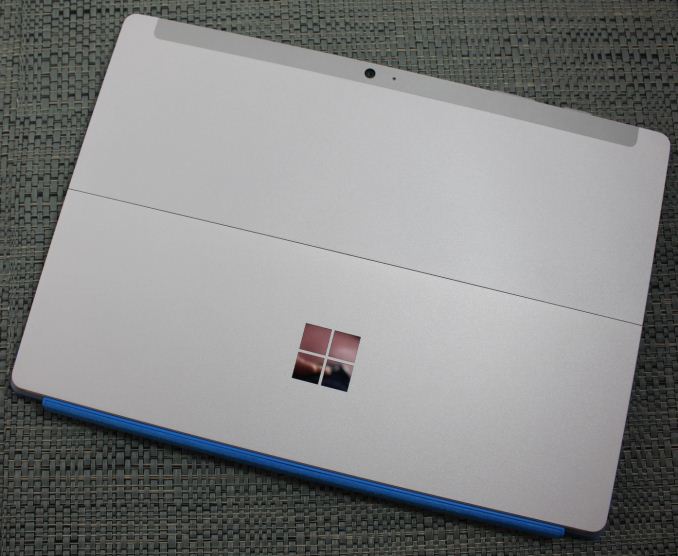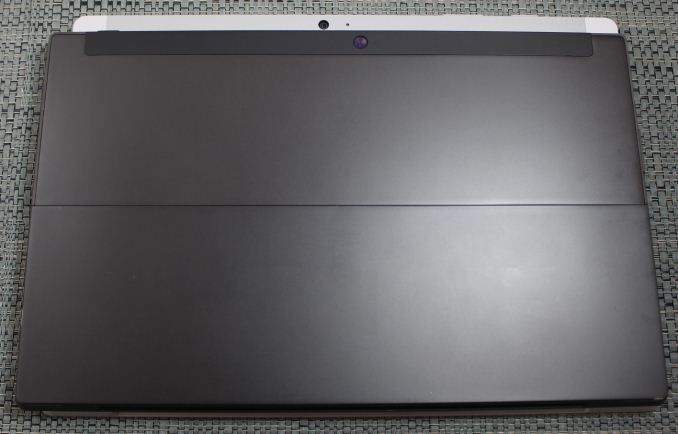The Surface 3 Review
by Brett Howse on May 4, 2015 9:00 AM EST
The Surface lineup for Microsoft has been extremely interesting to watch. What first launched in October 2012 as the Surface RT has been constantly iterated upon, and of course the Surface Pro line has evolved even faster. Surface Pro 3 has finally provided Microsoft with something that critics and consumers alike seem to have bought in to, and sales have been very strong since the Pro 3 was launched on May 20th 2014. However there has always been questions about the “consumer” version of Surface. Surface RT was, frankly, a sales disaster. The much improved Surface 2 fixed many of its shortcomings, but certainly did not set the world on fire. So now we have the third generation Surface, aptly named the Surface 3. There are a pile of changes that Microsoft has made to this generation of device, and obviously their hopes are that Surface 3 will be as popular as the Surface Pro 3 has been, but extending the device back down to a lower price point.
That price point is important. As much as the Surface Pro 3 has gained its share of fans, it is far from cheap. The most inexpensive model starts at $799, and for that you still do not get the keyboard. Surface 3 moves that bar down significantly, and the starting price is the exact same as the original Surface RT, at $499. Microsoft had to trim down the Pro model to hit this price point, but the cuts were well placed.
 Surface RT compared to Surface 3
Surface RT compared to Surface 3
I think looking at the Surface 3 in a vacuum would be improper, since the device now is really an evolution of the previous two Surface models. From a build quality standpoint, the original Surface RT was top notch, with its VaporMg case, the revolutionary kickstand, and high attention to detail for all of the aspects from buttons to display. I think in 2015 it is pretty obvious what the shortcomings of the Surface RT were though. Performance was less than acceptable with the Tegra 3 SoC on board, and Surface RT was handicapped with the confusingly named Windows RT operating system and the lack of software compatibility that goes with using an ARM CPU instead of traditional x86. Surface 2 fixed the performance issue by moving to NVIDIA’s Tegra 4 SoC, and while not the outright fastest tablet chip, it was at least in the ballpark. However it kept the Windows RT operating system at a time when everyone else had abandoned it.
Surface 3 has fixed that final issue and at the same time made some amazing improvements to the overall design and feel. Full x86 Windows is on tap, for better or for worse, and powered by a brand new SoC. This must be a special moment in history where a Microsoft built device is the launch vehicle for a brand new product from Intel. The Surface 3 is powered by the 14nm Intel Atom x7, in this case the x7-Z8700 model which is the current top of the line Atom processor. Codenamed Cherry Trail, this is the massaged Bay Trail cores now built on Intel’s now mature 14nm FinFET process, and they include the same GPU cores as Broadwell.
| Microsoft Surface Comparison | |||
| Surface 3 (Base) | Surface 3 (High) | Surface 2 | |
| Size | 10.52 x 7.36 x 0.34 inch 267 x 187 x 8.7 mm |
10.81 x 6.79 x 0.35 inch 275 x 173 x 8.8 mm |
|
| Weight | 1.37 lbs - 622 g | 1.49 lbs - 675 g | |
| Display | 10.8-inch ClearType Full HD Plus 1920x1280 resolution, 3:2 ratio 10-point multi-touch Surface Pen Support |
10.6-inch ClearType Full HD 1920 x 1080 resolution, 16:9 ratio 5-point multi-touch |
|
| Battery | 28 Wh, 13 W AC Adapter | 31.5 Wh, 24 W AC Adapter | |
| Storage | 64GB | 128GB | 32GB or 64GB eMMC |
| RAM | 2GB | 4GB | 2GB |
| CPU | Atom x7-Z8700 Quad Core 14nm 1.6 GHz Base Frequency 2.4 GHz Burst Frequency |
NVIDIA Tegra 4 4x ARM Cortex-A15 @1.7GHz |
|
| WiFi | Marvell 802.11ac + BT 4.0 LTE Models at a later date |
802.11n + BT 4.0 | |
| Ports | USB 3.0, Mini-DisplayPort, microSD, Micro USB charging, 3.5mm Headset Jack |
USB 3.0, micro-HDMI, microSD, proprietary charging | |
| Software | Windows 8.1 Office 365 Personal with 1TB OneDrive (1-year) |
Windows RT 8.1 Office 2013 RT Home & Student Edition |
|
| Front Camera | 3.5 MP | 3.5 MP | |
| Rear Camera | 8.0 MP with Autofocus | 5.0 MP | |
| Operating System | Windows 8.1 64-bit | Windows RT 8.1 | |
| Warranty | 1-year limited | 1-year limited | |
| Price | $499 | $599 | $449 |
In addition to the new SoC, Surface 3 can be purchased with up to 128 GB of eMMC storage, and the higher storage models also come with 4 GB of RAM. This compares to the base model which is 2 GB of RAM and 64 GB of storage, which is already one of the big improvements Microsoft has made with Surface. 32 GB of storage on a Windows tablet is really the bare minimum required, and the move to 64 GB as the base is going to make this tablet far more usable. You can of course add more storage with a micro SD card, but until Windows gets the great SD card support from Windows Phone, it still means that you need to manage your storage more than you should have to.
There are so many changes with the Surface 3 that really, this is likely the Surface that most people wanted from day one, but did not know it. First up is the new (again) kickstand.










265 Comments
View All Comments
extide - Monday, May 4, 2015 - link
Yeah, but that is only sequential -- in random I/I the eMMC will still beat the pants off a regular laptop hdd -- and that's what really matters.lilmoe - Monday, May 4, 2015 - link
Wouldn't you think that random speed not only makes up for that, but also makes it seem much faster in real life scenarios compared with HDDs?Anyway, UFS should make the gap much wider in future products. Samsung and others are working on super cheap modules. SSDs aren't needed in most segments.
magreen - Monday, May 4, 2015 - link
Yes, it is better in random access than a cheap laptop HDD. But I don't know if that's the only thing that matters. It's unbalanced, just like the early SSDs were. The early SSDs were unreasonably slow in random write, and this is unreasonably slow in sequential write.As to which is more essential to feel "fast," I think that may be in the eye of the beholder. Yes, this eMMC may have some snappiness to it due to quickness in random access, so it won't get slowed to a clickety-clackety crawl by a virus check, for example. But it's probably painfully slow to complete tasks we're not accustomed to waiting for (sequential). That may be what the reviewer is pointing out, that storage seemed to be a bottleneck.
68k - Wednesday, May 6, 2015 - link
Mechanical HD and eMMC is not even at the same level when it comes to which feel "faster". Random access is far more important for everyday use, which make eMMC superior in very close to 100% of the use cases.Random access performance of small sizes at low queue depth is what a disk targeting interactive usage should optimize for.
magreen - Wednesday, May 6, 2015 - link
Really? For a full-blown Windows install? How would you know?You're not making a fair comparison. Remember this thing runs full Windows 8.1. The whole purpose is that people can use their standard desktop applications. You can't just think of the speedup from a typical HDD to a typical SSD. You'd have to cripple the sequential access to make the assessment.
When was the last time you used an external SSD over USB 2.0 as your boot and programs install drive, to test your hypothesis? Or how about a microSD card as your boot drive? How slow would it be to fire up Microsoft Word? How about opening up a large video file? What about a file copy? You're not used to waiting for the sequential aspects of any of those because they're almost always >100MB/s, even on a cheapo 5400 rpm HDD.
jabber - Tuesday, May 5, 2015 - link
33MBps but far far lower latency which I find more effective/noticable than raw MBps. The average user won't be overly concerned.Too many of us here have just been spoilt.
tim851 - Monday, May 4, 2015 - link
I don't know, man. Here in Germany the Surface 3 64 GB is 10% more expensive than the iPad Air 2 with 64 GB. And I would never call an iPad 'good value', though it will likely hold its value better than the Surface.The Surface has the perk of running full Windows, but without a keyboard, I don't see anybody getting much use out of the desktop.
I personally still find the S3 pretty enticing, if only for the Stylus, which is another Apple-priced add-on. But I would call it good value, not to speak of "best value".
lilmoe - Monday, May 4, 2015 - link
Ok, but how many tablets do you know can do what the Surface 3 can at that price?I do agree that the accessories are on the overpriced side, but don't forget that they aren't the only accessories that work with this device, and it doesn't *need* them to deliver on its promise. I personally wouldn't be using it as a "laptop replacement" on the go, but at home or in the office, I'd connect it to a bluetooth/wireless mouse/keyboard and an external monitor if necessary...
This device works great for any type of media consumption since it's capable of running/viewing just about anything. It's also great for Office at home, or for your average secretary, assistant, HR, and sales employee for work. It's one of a kind device for these purposes.
Manch - Monday, May 4, 2015 - link
I have an original PRO and I use onenote on it religiously. Its replaced paper notebooks for me. I'm actually thinking about getting the S3. The pen is awesome. Marking up docs is great. Hand writing rec even works on my writing and I write right handed now bc of an injury. whether I'm at a tech conference or just at work, the device is awesome. My buddy has the S3 Pro and I drool about getting one. Thing is I have the dock, keyboard and what not already so I'm reluctant to buy again. I dont however need the power I have in the PRO. The regular S3 would work great.Manch - Monday, May 4, 2015 - link
I forgot to add, I dont see the desktop much on the PRO. I use it in tablet mode. Keyboard only gets snapped to it when i'm on the road bc its more than enough computing power. At my desk when docked i have an external monitor and kb mouse. With Windows 10 on it now, wow, so much better!